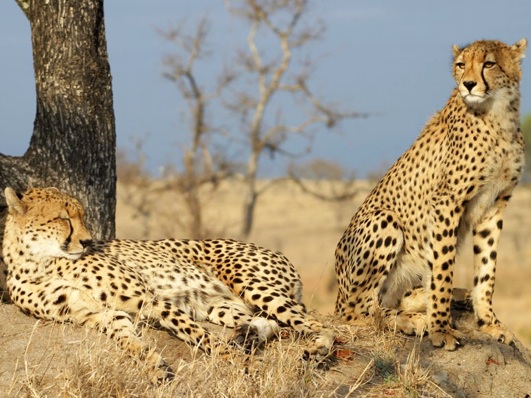Fact: The cheetah (Acinonyx jubatus) is a very fast sprinter. When chasing prey, it can top speeds over 60 miles an hour (97 km). This makes the cheetah the fastest land animal around! And what is the cheetah's top speed? The average top speed of cheetahs is about 64 miles an hour (102 km), and scientists feel this is also a good measurement of how fast a typical cheetah can run.
Source: BBC: Science and Nature, and Ranger Rick, May 1998, Ask Scarlett: Can cheetahs really run 70 miles an hour? - 112 km - cheetah speed.
Fact: For such a swift cat, a cheetah's body is not very long (only about 4 ft/1 m). Even so, in just one bound it can travel 20 feet (6 m), by using its long legs and flexible spine. According to researchers, it's thought that the cheetah's flexible spine alone enables the animal to run an extra 6 miles an hour (9.6 km).
Source: Built for Speed: The Extraordinary, Enigmatic Cheetah, by Sharon Elaine Thompson, page 27.
Fact: Cheetahs belong to the Felidae family, and unlike lions, cannot roar. Cheetahs can purr, however, as well as hiss, growl, whine, and call to each other with chirping birdlike sounds.
Source: African Wildlife Foundation.

Cheetah Image Source: World Resources Institute Staff / License under Creative Commons 2.0.
Background Image Source: tico24 / License under Creative Commons 2.0.
Artist Rendering: Sam Fall.
Available in three sizes:
1280 x 1024 || 1024 x 768 || 800 x 600
Fact: On average, cheetahs chase their prey for about ten seconds. The shorter the chase the better, for all the dust and movement might attract the attention of lions and hyenas-- animals that might decide to take their kills from them.
Source: National Geographic, December 1999, Cheetahs—Ghosts of the Grasslands, by Richard Conniff, page 14.
Fact: The famous "tear marks" at the corners of the eyes, are a dead giveaway that what you're looking at is a cheetah, and not a leopard. Cheetahs have solid black spots on a background of yellow or tan fur, and have 4 to 6 black rings at the end of its tail. A combination of spot patterns and ring patterns are a way for humans to identify one cheetah from another.
Source: The Cheetah Spot.
Fact: Just as athletes apply black grease under their eyes to cut down on the glare from brilliant lights, it is thought that the black markings running down the corners of the cheetah's eyes to its mouth might serve a similar purpose. Unlike lions and leopards, cheetahs hunt mostly during the day, when such antiglare aids would be most helpful.
Source: African Wildlife Foundation.

One cheetah stands guard over a friend
Image Source: James Temple / License under Creative Commons 2.0.
Available in three sizes:
1280 x 1024 || 1024 x 768 || 800 x 600
Did you know? It's rare for cheetahs to climb trees. They can jump onto low hanging branches and fallen trees, but adult cheetahs are not good climbers.
Source: Ranger Rick, February 1986, by Gerry Bishop, page 7.
Fact: Cheetahs hunt in a sequence of maneuvers known as "chase-trip-bite." After stalking its prey until it gets within a close range, the cheetah suddenly rushes its victim in a surprise attack. Using the only sharp claw on it's front paw-- the dewclaw-- the cheetah trips the animal, and then clamps down on the animal's throat until it suffocates. The chase over, the cheetah must rest and catch it's breath, all the while keeping an eye out for lions and hyenas, and then feast on its fresh kill.
Source: NATURE: Cheetahs in a Hot Spot - Fast Cats.
Fact: Hunting is an acquired skill, and young cheetahs learn by watching their mother. In Kenya, at the Masai Mara game reserve, a mother cheetah was seen capturing a baby gazelle unharmed, and then taking it back to her cheetah cubs. When the baby gazelle tried to escape, the mother cheetah coaxed her cubs to chase it. When they failed, the mother brought the baby back to her cubs again and again, until her young began to learn how to hunt. The cubs must learn all they can from their mother, for after 18 months, they will be on their own.
Source: Daily Mail, Amazing pictures of the cheetah cubs who developed a soft spot for their supper, by Jane Fryer.
- Cheetah Conservation Fund - A proactive organisation that finds practical solutions to help people to help the cheetah.
- Cheetah Web Cam - Live web cams of the four cheetahs at the National Zoo, a part of the Smithsonian Institute.
- Cheetah Jigsaw Puzzle - A jigsaw puzzle of a cheetah at the US FWS LE Kids Site.